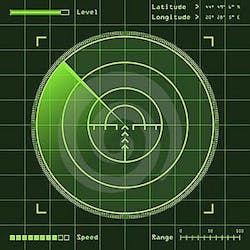DARPA issues solicitation for EW program to counter digitally programmable adaptive radar
ARLINGTON, Va., 17 July 2012.Electronic warfare (EW) experts at the U.S. Defense Advanced Research Projects Agency (DARPA) in Arlington, Va., want industry to find ways to detect and counter digitally programmable radar systems that have unknown behaviors and agile waveform characteristics.
DARPA released a broad agency announcement (DARPA-BAA-12-54) earlier this month for the Adaptive Radar Countermeasures (ARC) program, which seeks to develop EW capability to counter hostile adaptive radar systems based on their over-the-air signals.
Today's airborne EW systems are proficient at identifying analog radar systems that operate on fixed frequencies. Once they identify a hostile radar system, EW aircraft can apply a preprogrammed countermeasure technique.
Yet the job of identifying modern digitally programmable radar variants using agile waveforms is becoming more difficult. The ARC program seeks to enable systems to generate effective countermeasures automatically against new, unknown, or ambiguous radar signals in near real-time.
The program will develop new processing techniques and algorithms that characterize enemy radar systems, jam them electronically, and assess the effectiveness of the applied countermeasures.
DARPA conducted industry briefings for the ARC program on 10 July. Those interested in receiving may request briefing materials by e-mail at [email protected].
The goal of the Adaptive Radar Countermeasures (ARC) program is to develop ways to counter adaptive radar threats quickly based on over-the-air observable signals.
Threats of particular interest include ground-to-air and air-to-air phased array radars capable of performing several different functions, such as surveillance, cued target acquisition, tracking, non-cooperative target identification, and missile tracking. These kinds of radar systems are agile in beam steering, waveform, coding, and pulse repetition interval.
Key challenges to industry are clearly isolating the signal amid hostile, friendly and neutral signals; figuring out the threat the signal poses; and jamming the signal.
Today's airborne electronic warfare (EW) systems match enemy radar signals and determine appropriate countermeasures based a list of known threats, but are limited when enemy signals are ambiguous or not on the list.
Modern enemy radar systems, however, are becoming digitally programmable with unknown behaviors and agile waveform, so identifying and jamming them is becoming increasingly difficult.
Things will get worse in the future as radars develop the ability to sense their environment and adapt their transmission characteristics and pulse processing algorithms to defeat attempts to jam them.
The objective of the ARC program is to enable EW systems to generate effective countermeasures automatically against new, unknown, or ambiguous radar signals as they are encountered.
The ARC program seeks to develop new processing techniques and algorithms to counter adaptive radar threats through real-time analysis of the threat's over-the-air observable properties and behaviors.
DARPA officials say that software algorithms developed under the ARC program most likely will be used in existing or planned EW systems.
The ARC system should be able to isolate agile unknown radar threats in dense, complex electromagnetic environments with friendly, hostile and neutral RF emitters; counter these new radar threats; provide real-time feedback on countermeasure effectiveness; counter several threats at once; support single-platform or distributed, multi-platform operations; support autonomous and human-in-the-loop operation; and use a standards-based, modular, open and extensible software architecture. The system also should be able to store and download new knowledge and countermeasures for post-mission analysis.
The ARC program is a five-year effort. The first 30 months focuses on algorithm development and component level testing; the second 18 months focuses on systems development; and the remaining two years is for building a real-time ARC prototype.
Companies interested should respond no later than 29 Aug. 2012. Managing the ARC program is Yiftach Eisenberg, who can be reached by e-mail at [email protected]. Send questions or concerns by e-mail to [email protected].
More information is online at https://www.fbo.gov/spg/ODA/DARPA/CMO/DARPA-BAA-12-54/listing.html.
Follow Military & Aerospace Electronics and Avionics Intelligence news updates on Twitter

